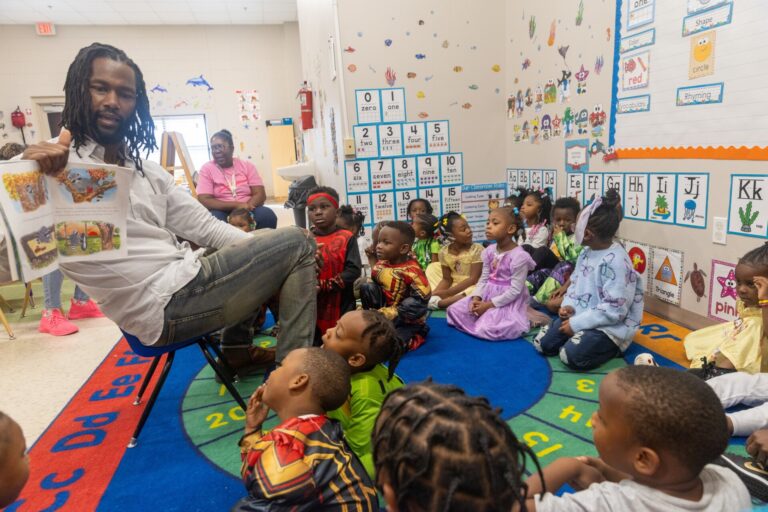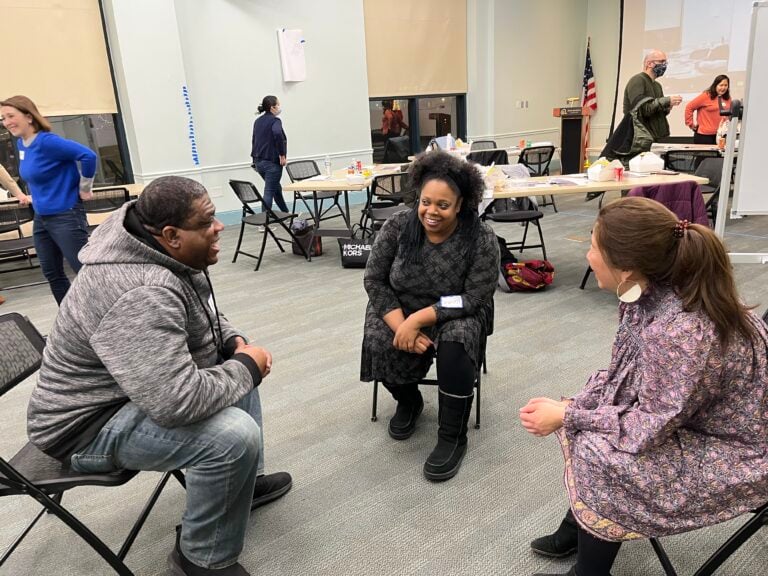Driving around the state of Missouri is part of Sarah Moody’s job. So is stopping to talk to people at gas stations and coffee shops. And sharing what she hears and sees with her colleagues at Missouri Foundation for Health (MFH), where she is director of community relationships, is the crux of it all.
“My whole job is just talking and listening to everyone I can out in the field,” she says, “and bringing it back to the foundation.”
During her travels, when she sees billboards that show support for the police, or notices issues bubbling up in conversations, like about transportation woes or concerns around human trafficking, she reports her observations.
Watch related video:
At Missouri Foundation for Health, Community Liaisons Listen and Build Connections

Her foundation colleagues learn from Moody through a shared database where she documents interactions with community members and donors; quarterly “Lunch and Learn” presentations she hosts with her community-liaison team; or updates they provide in reports and meetings with various staff members.
A 200-foot cross (known as the tallest in North America) that sits alongside a highway near Branson, Missouri, reminds Moody of how central Christian faith is to many people in the area. At the same time, she notes, MFH has a non-discrimination policy that renders organizations ineligible for funding if they require employees to be of a specific religion. When MFH learned that some faith-based groups were questioning the policy, Moody saw an opportunity to meet with those organizations and exchange ideas about their respective organizational values. MFH didn’t change its policy, but the process was successful in building greater mutual understanding and trust between the foundation and the faith-based community in that area.
My whole job is just talking and listening to everyone I can out in the field, and bringing it back to the foundation.
Sarah Moody, Missouri Foundation for Health
“This is how we are taking in the idea that there can be, there should be, an ongoing conversation, and, for us, a humility that allows us to listen,” Moody says.
Key to that humility, she says, is that her job no longer includes being a program officer, an aspect of her work that she shed a few years ago. Now, absent the typical funder-grantee power dynamics, her interactions with community members and nonprofit leaders can be more authentic and feel less transactional.
“I can say that I am here to get to know you and to learn from you,” she says. “It’s a way to build long-term relationships that might include grantmaking, but are about much more — mutual respect, support, and listening.”
Chris Lassiter, director of community engagement at the Community Foundation of the Central Blue Ridge (CFCBR), is listening in a similar way, ear to the ground and relationship building.
“My answer to that is you put yourself in position of being part of the fabric of the community,” he says about the way he approaches his role as a liaison for the foundation. He’s taught classes at the juvenile prison in the area and mentored high school students. When he identified housing insecurity as a top issue to address, he started going to lunch at a local homeless shelter once a week. Same day, same time.
“Mondays at 11:45,” he says, “it’s not a listening exercise, it’s having a meal at a place where people gather.”
The jobs Lassiter and Moody hold illustrate a growing trend among foundations to more formally integrate community engagement into their strategic and grantmaking processes. Other practices include regular community gatherings, focus groups, advisory councils, and inviting community members to serve on governing and grantmaking boards.
Having full-time community liaisons is one piece of the puzzle at MFH, says Moody, who started at what was then a new post in 2017. The foundation has since hired two more liaisons, who, like her, are primarily tasked with enhancing MFH’s rural perspective.
One place they’ve made a difference is in MFH’s Opportunity Fund, which solicits “concept papers” for projects on any topic, then invites some of the organizations to submit full proposals for grant money. Moody and her liaison team had been hearing that some groups based in rural areas were feeling left out when their concept papers were rejected. Now, community liaisons participate in reviewing concepts from organizations in rural areas, not to make funding decisions, but to help their MFH colleagues better understand the place-based background and context so important to understanding the ideas presented by the applicants.
“Something in our process was missing.” she says. “But that’s changed. Our whole team now looks more deeply at community context and that has allowed for a more informed and strategic selection process.”
Funder listening through what some call field-based staffing, has a more informal side to it, too. Lassiter at CFCBR was not sure how his efforts on a photo and audio project might impact grantmaking at his foundation, but he knew he wanted “to pass the microphone” to people experiencing housing insecurity.
He and a freelance photographer created a print photo gallery that has been displayed at schools and other community spaces, and a website that includes statistics and audio recordings about the photos, the people in them, and the issues reflected in the art.
Lassiter also worked with one of the high-school students he had mentored in the past to help him tell his story. The man, Jylil Smith, had faced challenges, especially around housing, after he served time in prison. Lassiter shared with the foundation’s board a 17-minute audio conversation he had with Smith and a few short video clips of Smith talking about his experiences, what defines him, and what affordable housing would mean to his and his family’s life.
“With this audio and visual experience for the board, we’re not telling them what to think, but just what to think about,” Lassiter says. “I’m very intentional about conveying what’s needed to inform the best decisions for our community.”







